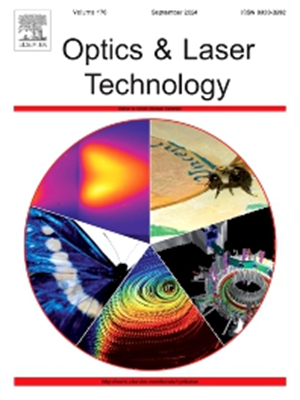A recurrent neural network with the residual connection for predicting the pulse characteristics in stress and polarization angle tunable laser
IF 5
2区 物理与天体物理
Q1 OPTICS
引用次数: 0
Abstract
The tunable fiber laser admits adjustment of the transmission characteristics of pulses, such as wavelength and width, required in practical applications. Because the available scale and range of tuning parameters are often limited in the experiment, systematic numerical simulations are often used to guide experiments. However, this approach has the disadvantages of consuming long computation times and the necessity of meticulously modeling complex systems. To realize a simpler and, simultaneously, more efficient and accurate approach to the modeling of complex fiber lasers, we have devised a bidirectional long short-term memory recurrent neural network with residual connections (res_BiLSTM RNN) for quick and reliable predictions of the pulse evolution in the fiber lasers, which may be controlled, in particular, by the bend-induced fiber stress and polarization angle. Predictions produced by the neural network for dependences of time-domain and spectral pulse characteristics on the control parameters agree well with experimental results. Compared to traditional numerical simulations, the computational efficiency of res_BiLSTM RNN is improved by two orders of magnitude. In addition, the prediction of the control law in the parameter range, which is difficult to achieve in the experiment, is consistent with results produced by the traditional numerical simulations. The res_BiLSTM RNN scheme can be applied to the real-time monitoring of pulses, providing guidance for the design of tunable fiber lasers, and it may find applications to other settings in nonlinear optics and photonics.
基于残差连接的递归神经网络预测应力偏振角可调激光器脉冲特性
可调谐光纤激光器允许在实际应用中对脉冲的传输特性,如波长和宽度进行调节。由于实验中可调参数的尺度和范围往往有限,因此通常采用系统的数值模拟来指导实验。然而,这种方法的缺点是计算时间长,需要对复杂系统进行细致的建模。为了实现一种更简单、更高效、更准确的复杂光纤激光器建模方法,我们设计了一种带有残余连接的双向长短期记忆递归神经网络(res_BiLSTM RNN),用于快速、可靠地预测光纤激光器中的脉冲演变,特别是受弯曲诱导的光纤应力和偏振角的控制。神经网络对脉冲时域和谱特性随控制参数变化的预测结果与实验结果吻合较好。与传统的数值模拟相比,res_BiLSTM RNN的计算效率提高了两个数量级。此外,在实验中难以实现的参数范围内的控制规律预测与传统数值模拟的结果一致。res_BiLSTM RNN方案可以应用于脉冲的实时监测,为可调谐光纤激光器的设计提供指导,并可应用于非线性光学和光子学的其他设置。
本文章由计算机程序翻译,如有差异,请以英文原文为准。
求助全文
约1分钟内获得全文
求助全文
来源期刊
CiteScore
8.50
自引率
10.00%
发文量
1060
审稿时长
3.4 months
期刊介绍:
Optics & Laser Technology aims to provide a vehicle for the publication of a broad range of high quality research and review papers in those fields of scientific and engineering research appertaining to the development and application of the technology of optics and lasers. Papers describing original work in these areas are submitted to rigorous refereeing prior to acceptance for publication.
The scope of Optics & Laser Technology encompasses, but is not restricted to, the following areas:
•development in all types of lasers
•developments in optoelectronic devices and photonics
•developments in new photonics and optical concepts
•developments in conventional optics, optical instruments and components
•techniques of optical metrology, including interferometry and optical fibre sensors
•LIDAR and other non-contact optical measurement techniques, including optical methods in heat and fluid flow
•applications of lasers to materials processing, optical NDT display (including holography) and optical communication
•research and development in the field of laser safety including studies of hazards resulting from the applications of lasers (laser safety, hazards of laser fume)
•developments in optical computing and optical information processing
•developments in new optical materials
•developments in new optical characterization methods and techniques
•developments in quantum optics
•developments in light assisted micro and nanofabrication methods and techniques
•developments in nanophotonics and biophotonics
•developments in imaging processing and systems

 求助内容:
求助内容: 应助结果提醒方式:
应助结果提醒方式:


